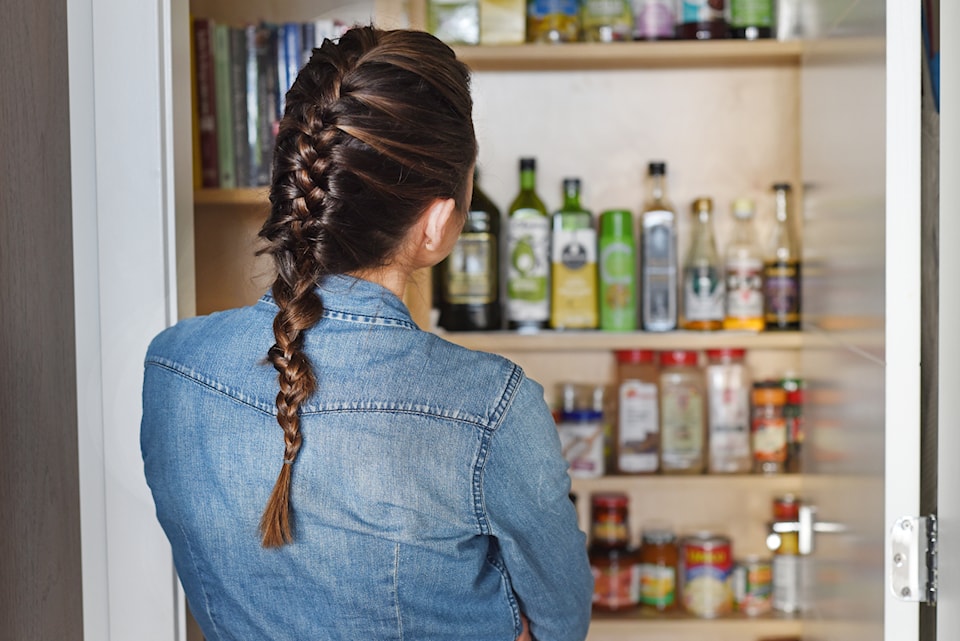We’ve all been there. A bit peckish, fridge door open, cupboards ajar, but alas with “nothing to eat.” Reluctantly you drag yourself to the grocery store, feeling forlorn and uninspired, a once subtle snackiness now a full-blown famished monster stirring within. Or perhaps you don’t even make it to the store and, in defeat, dial up delivery for a decidedly underwhelming take-away meal.
You may be surprised to learn that in this scenario, you might have had more options than you failed to realize in the moment. Many of us have cabinets full of ingredients that make marvellous meals, waiting dutifully for the right recipe or creative combination. And if you truly have empty shelves and a vacant fridge, this is your loving nudge to stock your cupboards with a certain collection of fail-safe and fool-proof go-tos that are either non-perishable or very long-lasting.
In modern times, a sparse (or uninspiring) stock of groceries is likely due to a lack of shopping, as opposed to a lack of supply. We are in the age of bounty and abundance and almost any ingredient, any time of year, is available for purchase in most highly serviced metropolitan centres. (This of course is in contrast to “food deserts” and conversations of accessibility, but that’s a topic for another day.)
However, humans have historically relied on pantries, larders, cellars and other such storerooms to house food and drink throughout the winter months, when the fields were bare and the animals were either hibernating, or themselves too starved to be eaten.
Making meals from jars, jugs, boxes and bins was a necessity, and canning, curing, preserving and rationing was a way of life – in many parts of the world, the only way to live. In fact, right about now (late winter and into early spring) fresh food supply would have been at its lowest, and we all would have been grateful for any pre-planning, preparedness and proactive preserving.
Perhaps you’re trying to eat more locally and your garden is looking lean after a long winter. Maybe you’re one of those folks who needs long-lasting ingredients on hand to inspire you between shopping trips. Either way the following recipes are great to keep on hand for those “rainy-day” occurrences.
Take pantry-ingredient-pleasing spaghetti alla puttanesca, a pasta dish seemingly originating in Naples in the mid-20th century. There are a few stories as to how this Italian staple became so popular.
One thought comes from a 2005 article from Il Golfo, which states that it was invented in the 1950s by Sandro Petti, co-owner of Rangio Fellone, a famous restaurant and nightspot. Allegedly, Petti’s inspiration came when, near closing one evening, he saw a group of customers sitting at one of his tables. He was low on ingredients and told them he didn’t have enough to make a meal. They asserted that it was late and they were hungry, saying, “Facci una puttanata qualsiasi,” meaning something akin to “make for us whatever the f- you got!”
Petti only had some anchovies, a few tomatoes, olives and capers left, and used them to make the sauce for the spaghetti, later including the dish on his menu as spaghetti alla puttanesca. Because “puttana” roughly means “prostitute” and puttanesca is an adjective derived from that word, there is a theory that the customers were sex workers in the area.
Alternatively, food historian Jeremy Parzen suggests the name has more to do with the practical use of “puttanesca” in Italian than with its literal definition, stating, “Italians use puttana (and related words) almost the way we use sh-t, as an all-purpose profanity. So pasta alla puttanesca might have originated with someone saying, essentially, ‘I just threw a bunch of sh-t from the cupboard into a pan.’”
So, read below for ways to convert items on the shelf into delicious meals.
(And if you’re wanting to learn how to can, jar, preserve, cure or otherwise stock your pantries full of delicious and useful non-perishables? Well, that’s a story for another issue, so stay tuned…)
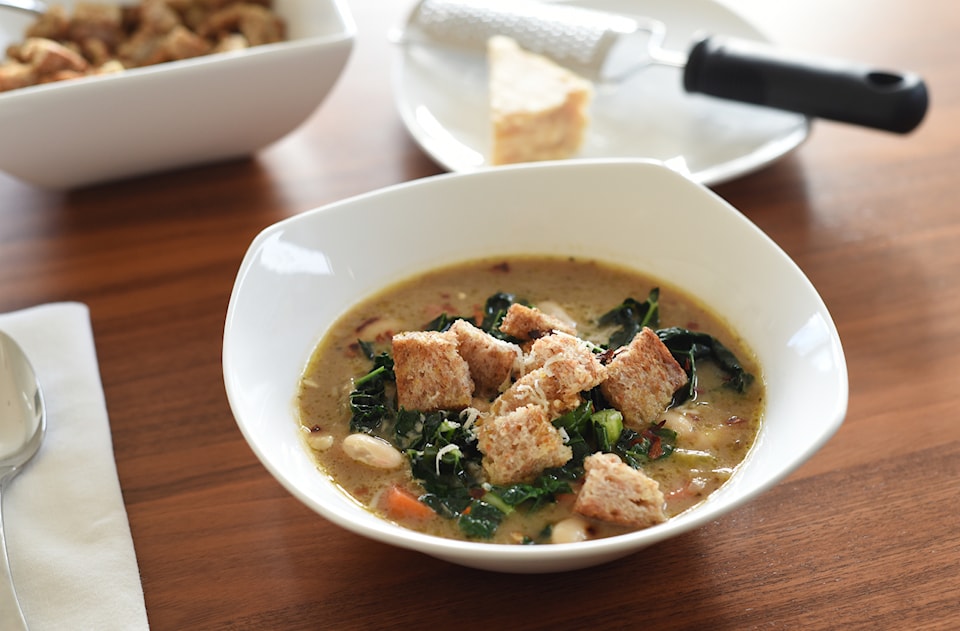
Rustic Tuscan-ned Bean Soup
Prep time: about 10 minutes
Cook time: about 20 minutes
Makes about 4 to 6 servings
Please ignore the painfully cheesy title and trust me when I say that this will become your go-to satisfying soup recipe. As you may notice, not all of the ingredients come from a can, jar or box, but the fresh items like garlic, shallot, onion, carrot and celery keep for a long time in a cool place, and kale grows rather abundantly through the cooler months in British Columbia. Of course, if you don’t have access to fresh versions of any of these veggies, you can freeze them in season and defrost before using.
Ingredients
¼ cup extra virgin olive oil
1 small onion, peeled and thinly sliced
1 large shallot, peeled and thinly sliced
4 cloves of garlic, peeled and minced
2 large carrots, peeled and cut into coins
2 large celery stalks, washed and sliced
1 15-oz can cannellini beans, drained and rinsed
2 dried bay leaves
1 tbsp dried oregano
½ tsp red pepper flakes
5-6 cups of broth
Sea salt and fresh cracked pepper to taste
1 large bunch fresh lacinato kale, washed and sliced thinly
Optional toppings of freshly grated Parmesan cheese, chopped parsley and/or rustic Italian croutons (recipe to follow)
Directions
Heat a couple tablespoons of olive oil in a large pot over medium heat.
Add the onions and shallots and sauté for 3 to 4 minutes, until translucent and just starting to brown. Then add the garlic and sauté until soft. Add a couple more tablespoons of olive oil, then add the carrots and celery and sauté for another 5 to 10 minutes (this is important to ensure that the flavors build).
Add the beans to the pot along with the bay leaves, oregano, red pepper flakes and broth. Season with salt and pepper to taste. Bring it all to a gentle boil, then reduce the heat to low, cover and simmer for another 15 minutes.
Meanwhile heat some more olive oil in a large pan on medium heat and sauté the kale until soft, then remove from the heat and set aside. Remove the soup pot lid to pull out and discard the bay leaves, then transfer two cups of the soup to a high-powered blender and blend until creamy and smooth (you may want to let it cool slightly before blending).
Return this blended mixture to the pot, stir until fully integrated and then add the cooked kale. Serve and garnish with more red pepper flakes, chopped parsley, freshly grated Parmesan and/or rustic Italian croutons (recipe to follow).
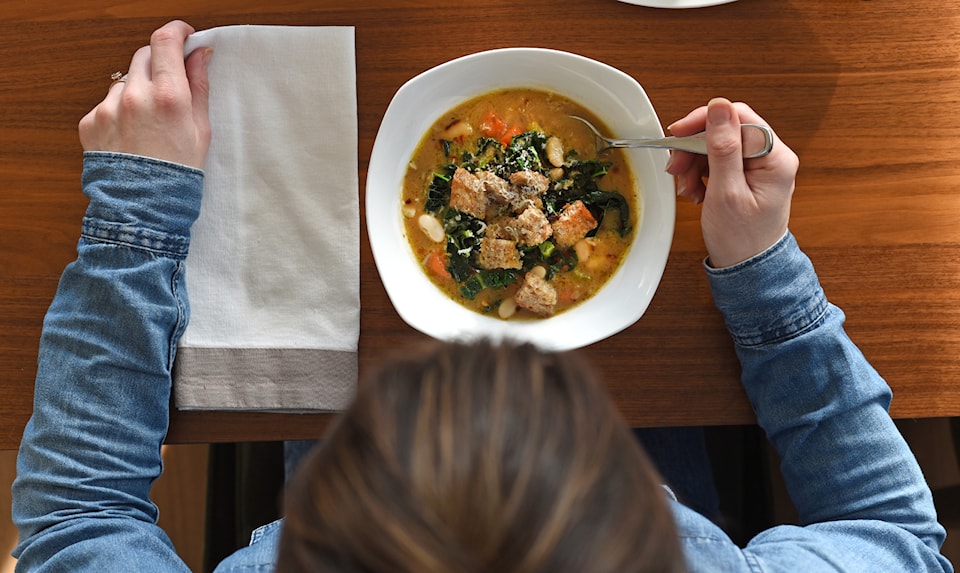
Rustic Italian Croutons
Ingredients
About 4 slices of rustic bread – you can use frozen then thawed or just some old stale bread), cut into ½ to 1-inch cubes
3-4 tbsp extra virgin olive oil
¼ tsp dried marjoram
¼ tsp dried oregano
¼ tsp garlic powder
Sea salt to taste
Directions
In a large bowl toss the bread cubes and seasoning, adding salt to taste.
In a large pan warm a couple tablespoons of olive oil over low heat.
Add the seasoned bread cubes and sauté until the cubes are crispy and browned, adding more olive oil as you go, and stirring regularly so the cook is even. Remove from the heat and set aside to cool fully before using.
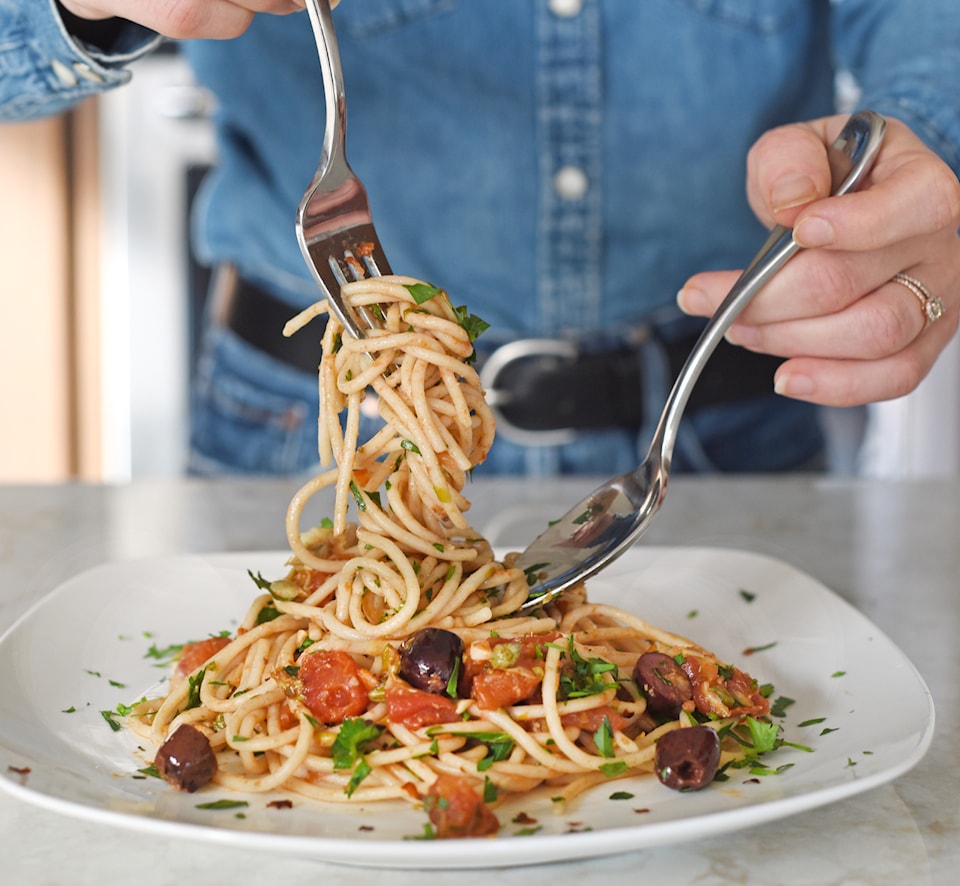
Pantry Puttanesca
Prep time: about 10 minutes
Cook time: about 15 minutes
Makes about 4 to 6 servings
This is an easy version of the classic, whereby I use canned tomatoes instead of fresh, and include some jarred artichokes for added texture (and because I had them on hand).
Ingredients
1 package (about 300 g) of spaghetti
¼ cup extra virgin olive oil
4 garlic cloves, peeled and minced
8-10 small anchovy fillets, rained, rinsed and finely chopped
1 tsp red pepper flakes
1 small jar (about 100 g) capers, rained, rinsed and roughly chopped
1 jar (about 300 mL) pitted olives, rained, rinsed and roughly chopped
1 jar (about 100 g) artichoke hearts, rained, rinsed and roughly chopped
1 large can (about 800 g) diced or rushed tomatoes (unsalted)
1 large handful fresh parsley, chopped
Freshly ground black pepper
Salt for pasta and to taste
Directions
Start boiling water for the spaghetti. Add salt once it starts to boil and cook until the pasta is al dente. Drain, keeping about a cup of pasta water on hand.
Heat some olive oil in a frying pan large enough to later hold the cooked pasta. Add the garlic, anchovies and red pepper flakes. Cook over a medium heat until the garlic is very lightly golden and the anchovies have melted, about 5 minutes. (Adjust heat as necessary to keep it gently sizzling.) Add the capers, artichokes, olives and a bit of parsley and stir to combine. Then add the tomatoes, stir and bring to a bare simmer for 5 to 10 minutes more so the flavours further develop.
As the sauce simmers, it may reduce a bit, at which point you can add some pasta cooking water – just a couple of tablespoons to keep the sauce thick and moist.
When ready to serve, combine the sauce and spaghetti, sprinkle with more chopped parsley, and enjoy!
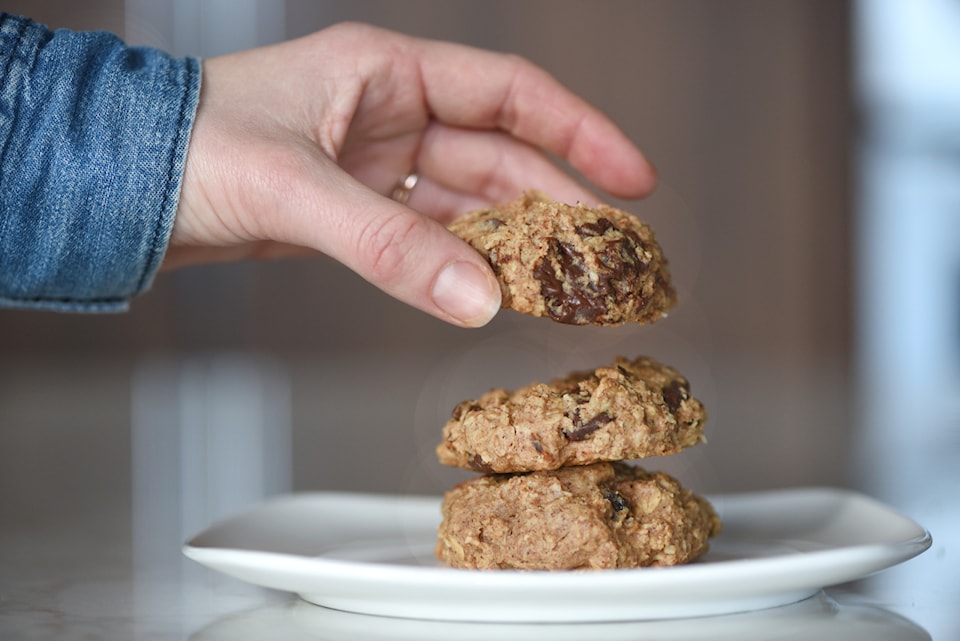
Cupboard Clean-Out Cookies
Prep time: about 10 minutes
Bake time: about 15 minutes
Makes about 2 dozen cookies
Not only do these cookies make delicious use of many long-lingering ingredients in your cabinets (in fact every single ingredient could come from your cabinet), they also keep for a while themselves. You can store them in an air-tight container on the shelf for up to a week, or in the fridge for a month, and the freezer indefinitely.
I personally just pop them in the oven at 350 F for a few minutes to bring them back to life before eating (make sure they’re defrosted before doing this if you’re using frozen ones). They’re also delightfully adaptable; substitute almond butter for any other nut or seed butter you have lying around, mix up the spices (or leave them out altogether) or switch up the nuts and fruit, depending on what you have on hand.
Ingredients
1 cup almond butter (or any plain, smooth nut or seed butter)
½ cup unsweetened apple sauce
½ cup pure maple syrup
¼ cup unsweetened almond milk (or any unsweetened on-dairy milk)
1 teaspoon pure vanilla extract
2 cups old fashioned rolled oats
1 cup almond flour
½ tsp baking powder
½ tsp baking soda
1 tbsp ground cinnamon
1 tsp ground ginger
¼ tsp ground cardamom
1⁄8 tsp ground clove
¼ tsp sea salt
¼ cup unsweetened coconut flakes
½ cup chopped nuts (shown here with almonds, pecans and cashews)
½ cup chopped dried fruit (shown here with apricots, dates and goji berries)
½ cup dark chocolate chunks
Directions
Preheat your oven to 350 F and line a baking sheet with parchment paper.
In a large bowl combine the rolled oats, almond flour, baking powder and soda, spices and sea salt, and set aside.
In another bowl or via an electric mixer, combine the almond butter, apple sauce, maple syrup, almond milk and vanilla extract until smooth.
Add the dry mixture to the wet mixture, and stir together until fully integrated.
Fold in the nuts, fruit, coconut and chocolate, and use a retractable ice cream scoop to form roughly one-quarter- to one-half-cup-sized scoops of batter into balls, patting the tops down a little to form more of a chunky cookie shape (they don’t spread out very much), and space each out evenly on your baking sheet.
Bake for about 15 minutes, until they’re just starting to brown on the edges, and then let them cool a bit on a wire rack before enjoying!
